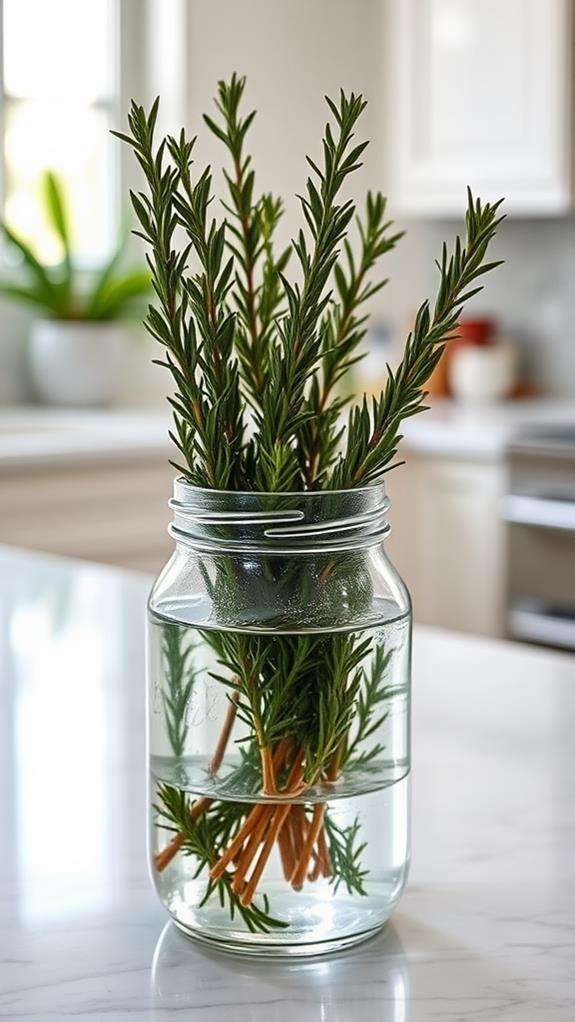How Long Does Fresh Rosemary Last
Fresh rosemary can last 5-7 days at room temperature, 2-3 weeks in your refrigerator, or up to 6 months when frozen. You'll get the best results by wrapping the sprigs in slightly damp paper towels and storing them in a perforated plastic bag in your crisper drawer at 35-40°F. For room temperature storage, place stems in a glass with an inch of water, changing it daily. Watch for signs of spoilage like yellowing leaves, mushy stems, or lack of aroma to guarantee freshness. Keep your rosemary unwashed until use, and you'll discover multiple ways to extend its shelf life even further.
This post may contain affiliate links. If you make a purchase through these links, I may earn a commission at no additional cost to you. Additionally, portions of this post may be generated using artificial intelligence (AI) technology. While we strive for accuracy, please be aware that AI-generated content may not always be perfect and should be fact-checked when necessary.
The Spatula Scoops
- Fresh rosemary lasts 5-7 days at room temperature, extending to 10-14 days when kept in water with daily changes.
- Refrigerated rosemary stays fresh for 2-3 weeks when wrapped in damp paper towels and stored in a resealable bag.
- Freezing preserves rosemary for up to six months, with vacuum-sealed storage extending freshness to 12 months.
- Store unwashed rosemary in the refrigerator's crisper drawer at 35-40°F for optimal preservation.
- Signs of spoilage include yellowing leaves, mushy stems, white spots, mold, or loss of aromatic scent.
Proper Storage Methods

Several storage methods help maximize fresh rosemary's shelf life. You'll get the best results by wrapping fresh rosemary sprigs loosely in slightly damp paper towels, then placing them in a resealable plastic bag. Before storing, make sure you've removed any damaged or discolored leaves, as these can promote premature spoilage.
If you're planning to use your rosemary within a week, you can store it upright in a glass with about an inch of water, similar to a bouquet. Cover the leaves loosely with a plastic bag, but don't seal it completely – the herbs need some airflow. You'll want to change the water every two days and trim the stems' ends when they become discolored.
For longer storage, you can create an herb roll by laying the rosemary sprigs on a damp paper towel, rolling it up carefully, and placing it in a resealable plastic bag. Store this in your crisper drawer, where the temperature stays consistent between 35-40°F. Remember to check periodically for any signs of wilting or mold, removing affected portions promptly to prevent spread.
Signs of Spoiled Rosemary

Fresh rosemary will display clear signs when it's starting to spoil. You'll want to check your herbs regularly for visual, tactile, and olfactory indicators that suggest deterioration. When examining your rosemary, pay particular attention to color changes, texture alterations, and any unusual odors.
| Warning Sign | What to Look For | Action Required |
|---|---|---|
| Visual Changes | Yellowing or blackening leaves, white spots, mold growth | Discard immediately |
| Texture Issues | Limp, mushy stems, dried-out brittle leaves | Remove affected portions |
| Smell Changes | Musty odor, fermented scent, lack of aroma | Replace with fresh herbs |
You'll know your rosemary isn't fresh anymore when the normally firm, dark green leaves become discolored or develop spots. If you notice the stems feeling slimy or see any fuzzy growth, it's time to dispose of the herbs. Don't try to salvage rosemary that's showing multiple signs of spoilage, as it could harbor harmful bacteria. The most reliable indicator is the herb's signature pine-like fragrance – when it's greatly diminished or replaced by an off-putting smell, you shouldn't use the rosemary in your cooking.
Room Temperature Shelf Life

Keeping rosemary at room temperature greatly limits its shelf life, which makes proper storage even more important than watching for spoilage signs. When you're storing fresh rosemary sprigs on your counter or in a pantry, you'll typically only get 5-7 days of usability before the herbs begin deteriorating.
If you've placed your rosemary in a glass of water like cut flowers, you might extend its room-temperature life to 10-14 days, but you'll need to change the water daily and trim the stems occasionally. Your kitchen's ambient temperature plays a significant role here – if it's consistently above 70°F (21°C), you'll notice faster degradation of the essential oils that give rosemary its distinctive aroma and flavor.
For best results at room temperature, you should wrap your rosemary loosely in slightly damp paper towels, then place it in a perforated plastic bag. This method helps maintain humidity while allowing excess moisture to escape, preventing premature wilting. Remember, you'll need to check the paper towels daily and re-dampen them if they've dried out completely.
Refrigeration Guidelines
The refrigerator offers the most practical storage solution for fresh rosemary, extending its shelf life to 2-3 weeks when properly stored. You'll want to wrap your fresh rosemary sprigs loosely in slightly damp paper towels before placing them in a resealable plastic bag or airtight container.
Before refrigerating your rosemary, make certain you've thoroughly inspected the sprigs and removed any yellowed, blackened, or wilted leaves. Don't wash the herbs until you're ready to use them, as excess moisture can lead to premature spoilage. If you've already washed them, verify they're completely dry before storage.
Place your wrapped rosemary in the crisper drawer of your refrigerator, where the temperature remains consistent and humidity levels are ideal for herb storage. You'll want to check the paper towels every few days, remoistening them if they've dried out completely or replacing them if they've become too wet. If you notice any condensation forming inside the storage container, open it briefly to allow excess moisture to escape. This prevents mold growth and helps maintain the rosemary's crisp texture and aromatic properties.
Freezing Fresh Rosemary

You'll find that freezing fresh rosemary is an excellent way to preserve its flavor and aroma for up to six months, especially when you remove the leaves from the stems and store them in airtight freezer bags. For the best results, wash and thoroughly dry your rosemary sprigs, then either freeze whole stems or strip the leaves before placing them in freezer-safe containers with all the air pressed out. If you're planning to use your rosemary in cooked dishes, you can also freeze the herbs in ice cube trays with olive oil or water, which helps prevent freezer burn and makes portioning easier.
Proper Freezing Methods
Freezing rosemary offers a practical way to preserve its intense flavor for up to 6 months. You'll need to follow specific steps to maintain the herb's aromatic compounds and prevent freezer burn. Before freezing, wash your sprigs thoroughly and pat them completely dry to avoid ice crystal formation.
| Step | Action |
|---|---|
| 1 | Remove leaves from woody stems |
| 2 | Flash freeze on lined baking sheet |
| 3 | Transfer to freezer-safe container |
| 4 | Label with date and contents |
| 5 | Store at 0°F (-18°C) or below |
You can choose between two reliable freezing methods. The first involves freezing whole sprigs in airtight freezer bags, while the second requires removing the leaves and freezing them in ice cube trays with olive oil or water. If you're using the ice cube method, fill each compartment about 2/3 full with chopped rosemary leaves, then top with liquid. Once frozen, transfer the cubes to a freezer bag, removing as much air as possible to prevent oxidation. You'll find these frozen herb cubes especially convenient for dropping directly into soups, stews, or sauces during cooking.
Long-Term Storage Tips
Successful long-term storage of frozen rosemary depends heavily on proper packaging and temperature control. You'll want to maintain a consistent freezer temperature of 0°F (-18°C) or below to prevent freezer burn and preserve the herb's essential oils.
To maximize storage life, you'll need to use freezer-safe containers or heavy-duty freezer bags with all air removed. If you're using zip-top bags, press out excess air before sealing, as air pockets can lead to oxidation and diminished flavor. You can also vacuum-seal your rosemary portions for peak preservation, which can extend storage life up to 12 months.
Label your containers with the date of freezing and expected expiration date. While frozen rosemary can technically last indefinitely, its quality and flavor intensity will gradually decline after 4-6 months. Store your frozen rosemary away from foods with strong odors, as herbs can absorb neighboring scents even when frozen. Don't store the containers in the freezer door, where temperature fluctuations occur frequently. Instead, place them in the back of your freezer where temperatures remain most stable.
Best Harvesting Practices

For the best harvest of fresh rosemary, you'll want to cut your stems in the morning after the dew has dried but before the day's heat sets in. Using clean, sharp pruning shears or garden scissors, make precise cuts at a 45-degree angle just above a leaf node, which helps promote healthy regrowth and prevents stem damage. Once you've gathered your rosemary stems, gently shake off any debris and inspect them for insects, ensuring they're completely dry before storing to prevent moisture-related deterioration.
Proper Cutting Time
When harvesting rosemary, timing plays an essential role in preserving its flavor and longevity. You'll want to cut your rosemary sprigs in the morning hours, specifically after the dew has dried but before the day's heat intensifies. This timing, typically between 9 AM and 10 AM, guarantees the plant's essential oils are at their peak concentration.
During the growing season, you can harvest rosemary at any time, but you'll get the best results by cutting just before the plant begins to flower. If you're planning a larger harvest, you should wait until late spring or early summer when the plant's growth is most vigorous. Don't cut more than one-third of the plant at once, as this could stress it and reduce future yields.
For the cleanest cuts, you'll need sharp pruning shears or scissors that you've sanitized with rubbing alcohol. Make your cuts just above a leaf node, at a slight angle, which encourages healthy regrowth and prevents water from pooling on the cut surface. If you're harvesting multiple sprigs, work from the outside of the plant inward, maintaining its natural shape.
Tools For The Job
Proper tools make all the difference in harvesting rosemary efficiently and safely. You'll need clean, sharp garden shears or pruning scissors specifically designed for herb cutting. While kitchen scissors might seem convenient, they often crush the stems instead of making clean cuts, which can damage the plant and reduce its longevity.
For the best harvesting results, keep these essential tools on hand: bypass pruners (which work like scissors), micro-tip pruning snips for precise cuts, and a pair of standard gardening shears for thicker, woodier stems. You'll also want to have clean, food-grade containers ready for storage and a spray bottle filled with water to clean your tools between cuts. If you're planning to dry your rosemary, you'll need garden twine for bundling and paper bags for the drying process.
Remember to sanitize your tools before and after each use with a solution of one part bleach to nine parts water, or use rubbing alcohol. This practice prevents the spread of plant diseases and guarantees you're working with clean equipment that won't contaminate your fresh herbs.
Clean and Dry Stems
Clean, healthy rosemary stems produce the best flavor and longest shelf life. Before you store your freshly harvested rosemary, you'll need to guarantee the stems are properly cleaned and dried to prevent mold and decay. Start by examining each stem carefully, removing any yellowed, damaged, or diseased portions.
Give your rosemary stems a gentle rinse under cool running water, making sure to clean between the needle-like leaves where dirt and insects often hide. You don't want to scrub too vigorously, as this can damage the plant's essential oils. After rinsing, gently shake the stems to remove excess water, then pat them dry with paper towels or a clean kitchen cloth. For the best results, you'll want to lay the stems in a single layer on a fresh, dry paper towel and allow them to air dry completely at room temperature for 1-2 hours. If you're in a hurry, you can use a salad spinner to remove most of the moisture, but you'll still need to let the stems finish air-drying before storage. Never store wet rosemary, as moisture accelerates spoilage.
Extending Rosemary's Freshness

Smart storage techniques can markedly extend your fresh rosemary's lifespan. You'll get the best results by wrapping your cleaned rosemary stems loosely in slightly damp paper towels, then placing them in a resealable plastic bag. Before sealing the bag, gently squeeze out excess air to prevent moisture buildup, which can lead to mold growth.
For ideal preservation, you'll want to store your wrapped rosemary in the crisper drawer of your refrigerator, where temperatures remain consistently cool. If you've stored it properly, your fresh rosemary can last up to two weeks, sometimes even longer. You'll know it's still good when the leaves remain firm and dark green, with no signs of wilting or browning.
If you notice any yellowing leaves or stems becoming soft, don't toss the entire bunch. Instead, carefully trim away affected areas, rewrap the healthy portions in fresh paper towels, and return them to the refrigerator. When you're ready to use your rosemary, remove only what you need and promptly return the rest to its storage container, maintaining the cold chain to preserve freshness.
Growing for Long-Term Use

The ultimate way to guarantee a continuous supply of fresh rosemary is to grow your own plant. You'll find that rosemary thrives in containers or garden beds, requiring well-draining soil and at least six hours of direct sunlight daily. If you're growing indoors, place your plant near a south-facing window for ideal light exposure.
You can start your rosemary from either cuttings or seedlings, though cuttings typically produce stronger plants that are genetically identical to the parent. When planting, verify your container has drainage holes and use a potting mix specifically designed for herbs. You'll want to water only when the top inch of soil feels dry, as rosemary's Mediterranean origins make it drought-tolerant and susceptible to root rot from overwatering.
To maintain your plant's health, prune it regularly, which encourages bushier growth and provides you with fresh sprigs. During growing season, you can harvest up to 2/3 of the plant's foliage without causing harm. If you're in zones 7-10, your rosemary can survive outdoors year-round; in colder regions, bring containers indoors before the first frost.
Frequently Asked Questions
Can Dried Rosemary Be Rehydrated to Use as Fresh Rosemary?
While you can rehydrate dried rosemary, it won't fully replicate fresh rosemary's texture and flavor profile. To rehydrate, soak the dried herbs in warm water for about 10 minutes, but you'll find the reconstituted herbs work better in cooked dishes rather than raw applications. The essential oils that give fresh rosemary its distinct aroma and taste aren't restored through rehydration, so you'll get better results using dried rosemary as-is in your recipes.
Does Rosemary Lose Its Flavor When Added Early in Cooking?
Ever wonder how timing affects rosemary's potency in your dishes? You'll find that rosemary actually holds its flavor remarkably well during extended cooking. Unlike delicate herbs that lose their punch quickly, rosemary's woody, pine-like oils are quite stable when heated. You can add it early in your cooking process, especially for slow-cooked dishes like stews and roasts, and it'll continue releasing its aromatic compounds throughout the cooking time.
Why Does My Rosemary Plant Turn Woody and Produce Fewer Leaves?
Your rosemary plant turns woody and produces fewer leaves when it's aging naturally or experiencing sub-optimal growing conditions. You'll notice this happens when you're not pruning regularly, which encourages woodiness and reduces new growth. If you're growing it in poor soil or providing irregular watering, your plant will also struggle. To prevent this, you'll need to prune regularly, maintain well-draining soil, and guarantee consistent moisture.
Can I Propagate Rosemary From Store-Bought Fresh Sprigs?
Yes, you can propagate rosemary from store-bought sprigs, but you'll need fresh, healthy stems. Take 4-6 inch cuttings, remove the lower leaves, and dip the cut end in rooting hormone. Plant them in well-draining potting mix, keep the soil consistently moist, and maintain warm temperatures around 70°F. You'll typically see roots develop within 2-3 weeks, though success rates may vary as store-bought sprigs aren't always ideal for propagation.
Is It Safe to Eat Rosemary Flowers Along With the Leaves?
You might think those pretty purple rosemary flowers are just for show, but you're in for a treat! Yes, it's completely safe to eat rosemary flowers, and they're actually quite delightful. They'll give your dishes a milder, more delicate rosemary flavor compared to the leaves. You can use them fresh in salads, as a garnish, or even crystallize them for dessert decorations. They're both edible and decorative.





